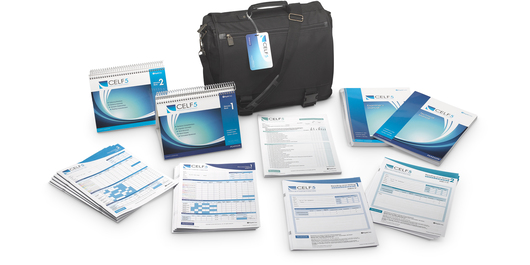
The Clinical Evaluation of Language Fundamentals, Fifth Edition (CELF-5) is one of the most widely used tools for assessing language abilities in children. However, despite its popularity, significant limitations exist in its ability to accurately diagnose Developmental Language Disorder (DLD) and identify subtle language and literacy needs. These limitations are particularly evident in its construct validity, psychometric properties, and its lack of alignment with academic language expectations. Clinicians must critically examine these concerns and exercise caution when relying on the CELF-5 for diagnostic purposes.
The construct validity of a language assessment refers to its ability to measure what it purports to measure—in this case, whether a student has a language disorder. For the CELF-5, construct validity is largely determined by its sensitivity (the ability to identify those with a language disorder) and specificity (the ability to exclude those without a language disorder). While the CELF-5 claims high sensitivity and specificity under certain conditions, a closer examination reveals significant flaws. The CELF-5’s technical manual reports high sensitivity and specificity (97%) when using a cutoff score of 1.3 standard deviations below the mean, which meets the “good” standard set forth by Plante and Vance (1994). However, when the cutoff score is lowered to 2 standard deviations below the mean, sensitivity plummets to 57%, rendering the CELF-5‘s accuracy barely better than chance (Wiig et al., 2013). Moreover, the sensitivity group for the CELF-5 includes only 66 students with language disorders (Wiig et al., 2013), an unacceptably small sample size for establishing the validity of a tool used to assess such a broad population.
One of the most critical issues with the CELF-5 is its reference standard, or the criteria used to determine which individuals are placed in the sensitivity and specificity groups. According to its technical manual, the reference standard for the sensitivity group is students scoring 1.5 standard deviations below the mean on any language test and receiving speech-language services. For the specificity group, it is students not receiving services (Wiig et al., 2013). However, these criteria are flawed for several reasons:
- Circular Reasoning: The CELF-5’s definition of “language disorder” is based on whether students are already receiving services, which creates a self-fulfilling prophecy. This means the test’s accuracy is evaluated against students it already deems disordered or typical, rather than an independent “gold standard.”
- Flawed Sensitivity Group: Over half of the students in the CELF-5 sensitivity group were identified using previous iterations of the CELF (e.g., CELF-4) or the PLS-3, which themselves have questionable construct validity. For example, the PLS-3 sensitivity ranges from 36%-61% for children aged 3-5, meaning it fails to identify up to 64% of children with language disorders (Zimmerman et al., 1991, as cited in Crowley, 2010). The CELF-3 sensitivity is 57% when considering only children with language disorders (Ballantyne et al., 2007). These flawed tests serve as the foundation for identifying the sensitivity group in the CELF-5, perpetuating inaccuracies across revisions.
- Bias in Specificity Group: The absence of speech-language services does not reliably indicate the absence of a language disorder. Many children with undiagnosed language disorders may be excluded from services due to systemic barriers or misidentification.
Overreliance on Arbitrary Cutoff Scores: Research shows that the use of a 1.5 standard deviations below the mean cutoff to define language disorder is arbitrary and inconsistent (Spaulding et al., 2006). Each test varies in its diagnostic accuracy, and there is no universal threshold for identifying language disorders. The CELF-5 lacks evidence to justify its cutoff score, which undermines its diagnostic validity.
Misalignment with Academic Language Expectations: The CELF-5 primarily assesses discrete language skills (e.g., sentence structure, word associations) rather than functional academic language. This creates a disconnect between its test items and the demands of the classroom, where language is often integrated across domains such as reading comprehension, written expression, and problem-solving. For example:
- Narrative Skills: The CELF-5 does not provide opportunities to evaluate a child’s ability to produce coherent narratives, a skill critical for academic success.
- Literacy Correlation: The CELF-5 tasks do not align well with academic language skills such as inference-making, reading fluency, or understanding complex syntax in texts. This misalignment makes the CELF-5 an inadequate tool for diagnosing language-based learning disabilities.
Implications for Clinicians: Given the CELF-5’s construct validity issues, psychometric weaknesses, and poor alignment with academic expectations, clinicians should use it with caution. The CELF-5 may provide insights into a child’s language profile if the child is severely language impaired but should not be the sole basis for diagnosis or intervention planning. Instead, clinicians should consider more reliable tools such as psychometrically solid comprehensive assessments, clinical grade level assessments of narratives/discourse, reading, and writing as well as comprehensive language evaluations, which combine multiple standardized and clinical assessment tools and observational data.
Conclusion: While the CELF-5 remains a commonly used tool, its limitations in construct validity, reliance on flawed reference standards, and poor correlation with academic language needs call into question its role in diagnosing DLD and supporting children with mild and moderate language and literacy difficulties. Clinicians must carefully consider these limitations and adopt alternative assessments with stronger psychometric foundations and psychometric validity. By doing so, they can ensure more accurate diagnoses and effective interventions for children with language and literacy challenges.
References
- Dollaghan, C. A. (2007). The Handbook for Evidence-Based Practice in Communication Disorders. Baltimore, MD: Paul H. Brookes Publishing Co.
- Plante, E., & Vance, R. (1994). Diagnostic accuracy of two tests of preschool language skills. Journal of Speech, Language, and Hearing Research, 37(2), 411-421.
- Spaulding, T. J., Plante, E., & Farinella, K. A. (2006). Eligibility criteria for language impairment: Is the low end of normal always appropriate? Language, Speech, and Hearing Services in Schools, 37(1), 61-72.
- Wiig, E. H., Semel, E., & Secord, W. A. (2013). Clinical Evaluation of Language Fundamentals, Fifth Edition (CELF-5). Pearson.
- Zimmerman, I. L., Steiner, V. G., & Pond, R. E. (1992). Preschool Language Scale, Third Edition (PLS-3). Harcourt Brace.